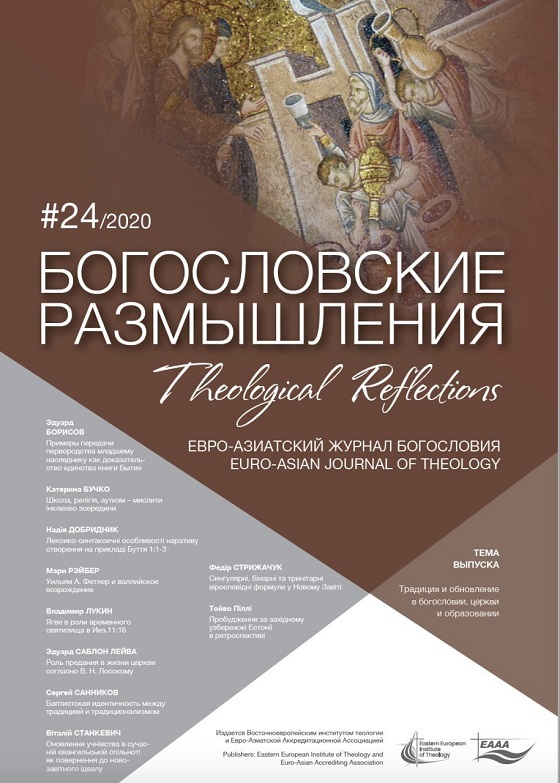ESTONIAN WEST COAST REVIVAL IN RETROSPECT: THE BIBLE AS A TOOL FOR INTERPRETING CHANGE
DOI:
https://doi.org/10.29357/2521-179X.2020.24.10Keywords:
West Coast Revival in Estonia, biblical interpretation, religious change, separation from traditional churches, enthusiasm, persecution.Abstract
The West Coast Revival in Estonia, in the 1870s and 1880s, emphasised conversion, ethical lifestyle and a joyful, experiential discipleship. This was a new, congregational paradigm that emerged in this movement, in the westernmost areas of Tsarist Russia. The Revival was deeply rooted in a fresh reading of the Bible, even if its adherents used simple and literal interpretation. Both the Moravian tradition and Swedish neopietism encouraged individual and collective hermeneutics. The Revival, being inspired by both, however, made conclusions that reached further: these awakened farmers separated from the Lutheran church, began to conduct baptism and communion independently, and discussed biblical passages between themselves in order to find guidance in the midst of religious changes. As a result,
Revivalist free churches and Baptist churches were established in Estonia. The authority of the biblical texts, on which the revivalist believers built their convictions, according to their best understanding, offered new selfconfidence. Indirectly, this contributed to a strengthening of national self-awareness. The article argues that there were at least three areas where biblical interpretation helped to find guidance and convictional courage. Firstly, the Bible was used to motivate and explain independent worship, separate ecclesial patterns and maintaining a distance from the existing mainline churches, Lutheran or Orthodox. Secondly, scriptural language and images functioned both to justify and balance emotional phenomena which were characteristic of the Revival. And thirdly, biblical examples helped to interpret persecution and suffering that the revivalist believers met both from the traditional churches and from Tsarist Russian officials.
References
- Bibliography
- Alttoa, Villem, and Paul Ariste, “Ühest varjujäänud õppeasutisest. Passlepa seminar 1873-1887” [About a Forgotten Educational Institution: Passlepa Teachers’ Seminary
- -1887], Eesti Kirjandus, no. 5 (1936), pp. 224-229.
- Busch, Mihkel, Ridala ärkamise ajalugu [A History of the Revival in Ridala] (Keila: K.-Ü. “Külvaja” trükk, 1928).
- Culpepper, Alan R., “Scripture“, in R. Wayne Stacy, ed., A Baptist’s Theology (Macon, Georgia: Smyth and Helwys Publishing, 1999), pp. 79-100.
- Eesti Baptisti koguduste ajaloolik Album 25 Juubeli aasta mälestuseks [In Commemoration of the 25th Anniversary: A Historical Album of Estonian Baptist Churches] (Tallinn, 1911).
- Kaups, Richard, ed., 50 aastat apostlite radadel [50 Years in the Footsteps of the Apostles] (Keila: E.B.K. Kirjastus, 1934).
- Paul, Toomas, Eesti piiblitõlke ajalugu [A History of Estonian Bible Translation] (Tallinn: Emakeele Selts, 1999).
- Pilli, Toivo, “Eesti baptistid ja nende teoloogilise mõtte kajastumine ajakirjas “Teekäija” kuni 1940” [Estonian Baptists and Their Theology as Reflected in Teekäija until 1940], master´s thesis (University of Tartu, 1996).
- Pilli, Toivo, “The West Coast Revival in Estonia, 1873-1884: Paving the Way for Baptist Mission”, Baptistic Theologies, no 1 (Spring 2018), pp. 1-17.
- Plaat, Jaanus, Usuliikumised, kirikud ja vabakogudused Lääne- ja Hiiumaal [Religious Movements, Churches and Free Churches in West-Estonia and Hiiumaa Island] (Tartu: Eesti Rahva Muuseum, 2001).
- Saard, Riho, “Baptismi Viron ja Pohjois-Liivinmaan kuvernementeissa, 1865-1920“ [The Baptist Movement in the Provinces of Estonia and North-Livonia, 1865-1920], pro gradu thesis (Helsinki University, 1994).
- Sakala, no. 4 (24 January 1881).
- Schultz, Woldemar, “Die neue Bewegung unter dem estländischen Landvolk“ [A New Movement among Estonian People], Baltische Monatsschrift, vol. XVII (1880), pp. 579-588.
- Schwak, Toomas, “Kirikuvahetusliikumine Liivimaal“ [Conversion Movement in Livonia] and “Kirikuvahetusliikumine Eestimaal” [Conversion Movement in Estonia], in Riho Altnurme, comp. and ed., Eesti kiriku- ja religioonilugu [A History of Church and Religion in Estonia] (Tartu: Tartu Ülikooli Kirjastus, 2018), pp. 191-194, 196-197.
- Seppur, Aleksander, Jees. Krist. Evg. Priikoguduse tekkimine ja levinemine Läänemaa ärkamises [The Beginning and Development of Jesus Christ’s Evangelical Free Church in the Revival of Western Estonia] (Toronto, 1970).
- Sild, Olaf, and Vello Salo, Lühike Eesti kirikulugu [A Short Estonian Church History] (Tartu, 1995).
- Talve, Ilmar, Eesti kultuurilugu [A History of Estonian Culture] (Tartu: Ilmamaa, 2004).
- Tuttar, H., and H. V. Dahl, Ärkamise aeg [A Time of Revival] (Tallinn: EBK Selts, 1929).
Downloads
How to Cite
Issue
Section
License
Copyright (c) 2020 Toivo PILLII

This work is licensed under a Creative Commons Attribution-NonCommercial 4.0 International License.
All articles published in the Journal are distributed under a Creative Commons Attribution-NonCommercial 4.0 International License
By submitting an article for publication in Theological Reflections: Eastern European Journal of Theology the author grants the editors the right to publish the article and distribute it in electronic and print form.
The author reserves all copyrights and the right to use the materials of the article in whole or in part for educational purposes, to write his own dissertations, to prepare abstracts, conference reports, oral presentations, etc., as well as post electronic copies of articles (including the final electronic version downloaded from the journal’s official website) on non-commercial web-resources without the consent of the editorial board and founders.



